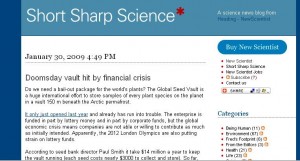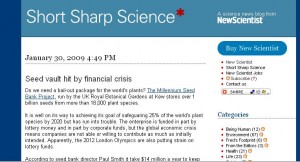The Root Crops Agrobiodiversity Project in Vanuatu is inventorying varieties in various villages around the archipelago, and coming up with some astonishing results. ((Although an old Pacific hand of my acquaintance disputes the inclusion of the Solomon Islands in this statement from the press release: “In other Pacific archipelagos, such as New Caledonia and the Solomon Islands, the introduction by the Europeans of new root and tuber species, combined with the arrival of a market economy, has totally disrupted the existing systems.”)) But, crucially, the work will not stop there. One of the objectives of the project is “to identify new varieties aiming at broadening the existing genetic bases and to propose them to producers and users, taking into account their needs and preferences.” So it’s more than the usual 3Cs — collect-characterize-conserve. There’s also creation, and dissemination, of new diversity, via seed production. That’s not that easy to do with taros and yams, but then, neither is conservation in conventional field and in vitro genebanks. It’s a very sensible idea to get the diversity increasing and moving around, rather than locking it up on research stations.
Nibbles: Bees, Honey, Fertilizers, Desertification, Nutrition, Decor, Mobile phones
- Bees under lots of “sub-lethal stresses.” I know how they feel.
- Hadzabe, who have been doing it for thousands of years, to be trained in honey production.
- Chinese farmers to be taught law of diminishing returns.
- “Workers at the Egyptian Desert Gene Bank in Cairo harvest and grow threatened desert species in its laboratory before replanting them to their native soils, hoping to revitalize threatened desert species.”
- Lao National Nutrition Policy puts nutrition at the centre of development.
- Economic botany and architectural fripperies.
- Got milk?
Nibbles: Rescue, Biofuels, Striga, Dogs, Vegetable seed, Mulberry, Afghanistan, Aquaculture, Abaca
- Global Crop Diversity Trust “on track” to reinvigorate 100,000 varieties, “one of the largest and most successful biological rescue efforts ever undertaken”. Jeremy says: “Kariba Dam.”
- More reasons to go perennial. And native to boot.
- Farmers go crazy with Striga-resistant maize.
- Design-a-pooch just around the corner, thanks to genome sequencing. Well it was all worth it then, wasn’t it.
- AVRDC teaches Solomons farmers to save seeds, grandma to suck eggs.
- Mulberries cryopreserved. Yay! Now for that productivity.
- Turning grapes to raisins, swords to plowshares, in Afghanistan.
- District Fishery Officer (In-charge) tells of guy “farming in a floodplain adjacent to Coler Beel under the same upazila and earns a net profit of Taka 9 lakh after selling 80 metric tons of harvested fish from the Beel last year.”
- Abaca: quantity or quality?
A citrus species in need of research?
It seems that citrus canker, a nasty bacterial disease, has been officially eradicated in Australia. Good news, but there is a bit of a dark lining. Along with 495,000 commercial citrus trees and 4000 residential trees, the eradication programme has included destroying a lot of trees of native Citrus glauca in the affected area. Desert Lime is well-known bush tucker, as well as a potential resource for Citrus breeding. It’s not currently considered endangered, but there’s not really all that much research about it ((That’s a bit of a casual way of introducing the fascinating Australian New Crops Web Site. Thanks to Danny for the tip.)), so that might be optimistic. There are only 8 germplasm accessions worldwide (page 29), apparently. That sounds inadequate to me. Especially given the historic proportions of the current drought, which is affecting the whole of SE Australia, including areas of C. glauca.
LATER: See also a map of the latest spate of bushfires in Australia. A threat to this and other crop wild relatives?
New Scientist bottles it
I have a lot of respect for the New Scientist. I really do. I kind of grew up with it. But I don’t think it handled the Great Seed Bank Confusion very well. Let me remind you. Last week a blog post went up at Short Sharp Science confusing the Millennium Seed Bank at Kew with the Svalbard Global Seed Vault, which is demonstrably not at Kew. Here’s a screen grab of that original post (click to enlarge):

That was bad enough, as both places have been in the news a lot lately, and it elicited the predictable flood of comments ((Even one by me!)) — some unpardonably rude, it must be admitted ((Not mine!)) — setting the blogger right. But it was nearly a week before the post was corrected, thusly:

And, rather than being up-front, the apology for the mistake, and the notice that a correction has been made, is buried in the 18th comment.
Journalists often bitch and moan about bloggers not being sufficiently professional about checking sources etc etc. I think New Scientist was unprofessional in making the original mistake — but hey, that happens — but also, and unforgivably, in not owning up to it quickly and visibly enough. Anyway, at least now everyone knows the difference between Kew and Svalbard.